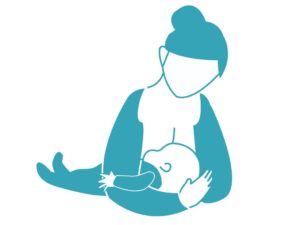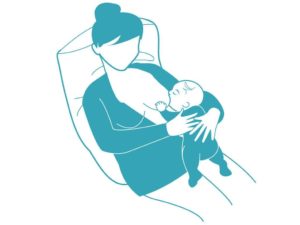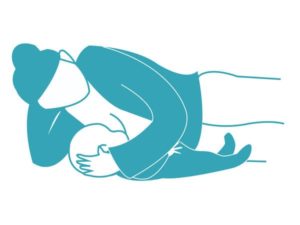Breastfeeding can be a stressful time for mamas. New moms often lose focus of their own comfort as they are pre-occupied with ensuring that their baby is latching, being well fed and comfortable. On top of that, it is common for mothers to continue to be hyper-mobile for up to 12 weeks postpartum due to the influence of hormones on the ligaments and connective tissues of the body. The weight of a growing baby and hyper-mobility of the body can lead to aches and pains in the neck, back and shoulders when breastfeeding.
Here are some tips and positions to try if you find you are experiencing some of these pains!
Cradle Hold – Position your babe on your forearm so that their head rests along the crease of your elbow on the side that you will be breastfeeding, and your hand supports the rest of your body. Your other hand will support your breast. Place pillows on your lap so that you can support your arm and raise your baby up to the appropriate nipple height. This will help prevent you from bringing your breast to the baby and getting caught in a hunched position. You can also try using a footrest to support your legs and low back while keeping your baby elevated.

Crossover Hold – Position your little one in the arm opposite to the breast you will be nursing from. Place his/her head in your hand, with your thumb behind one ear and other fingers behind the other ear. Your wrist should rest in between his/her shoulder blades. Use your other hand to support your breast. Similar to the cradle hold-use pillows and a footrest to help support yourself.

Football/Clutch Hold – This position is particularly helpful if you have twins, large breasts, or had a C-section and want to avoid placing your baby against your abdomen. Tuck your baby’s legs under your arm (exactly like a football) on the same side that you’re nursing on, so that he/she is facing you. Support the head with your hand and use your other hand to support your breast. Make sure you are sitting upright with your back and shoulders supported. Again, place pillows in your lap, closer to the side that the baby is on, to support your arm and little one.

Laid-back Position – This position is great for stimulating feeding reflexes in babies. It is also helpful for moms with smaller breasts, newborn babies, and babies with sensitive tummies or excess gas. Lie back in a semi-reclined position and make sure your head and shoulders are well supported by pillows. Have your little one lie face down on your stomach (so they are tummy-to-tummy) and their mouth positioned at your nipple. Gravity will help keep your baby in the ideal position and will also help to deepen their latch. Once your baby is feeding, you don’t have too much to do besides lay back and relax!

Side-lying Position – This position is great in the middle of the night if you are already half asleep, however, it requires a lot of pillows for support. Place pillows behind your back, under your head and between your knees to maintain a neutral spine position. Place your baby on their side, facing you so that their mouth is in line with your nipple. You can cradle their head with either arm, whichever feels more comfortable. Use pillows to prop your baby up if need be so that no one is straining.

Give these positions a try if you notice you are having neck, back and shoulder aches when breastfeeding. This should be a wonderful bonding experience between you and your babe, so do whatever it takes to get comfortable and protect your body. These aches and pains can also be treated through manipulation and soft tissue work! As always, be sure to check with your healthcare provider if you have any questions or concerns about your or your baby’s health.
Resources
https://www.whattoexpect.com/first-year/breastfeeding/positions/
https://www.babycenter.com/0_positions-and-tips-for-making-breastfeeding-work_8784.bc
Roberts D. Preventing Musculoskeletal Pain in Mothers Ergonomic Tips for Lactation Consultants. Clinical Lactation. 2011 Dec 1;2(4):13-20.

